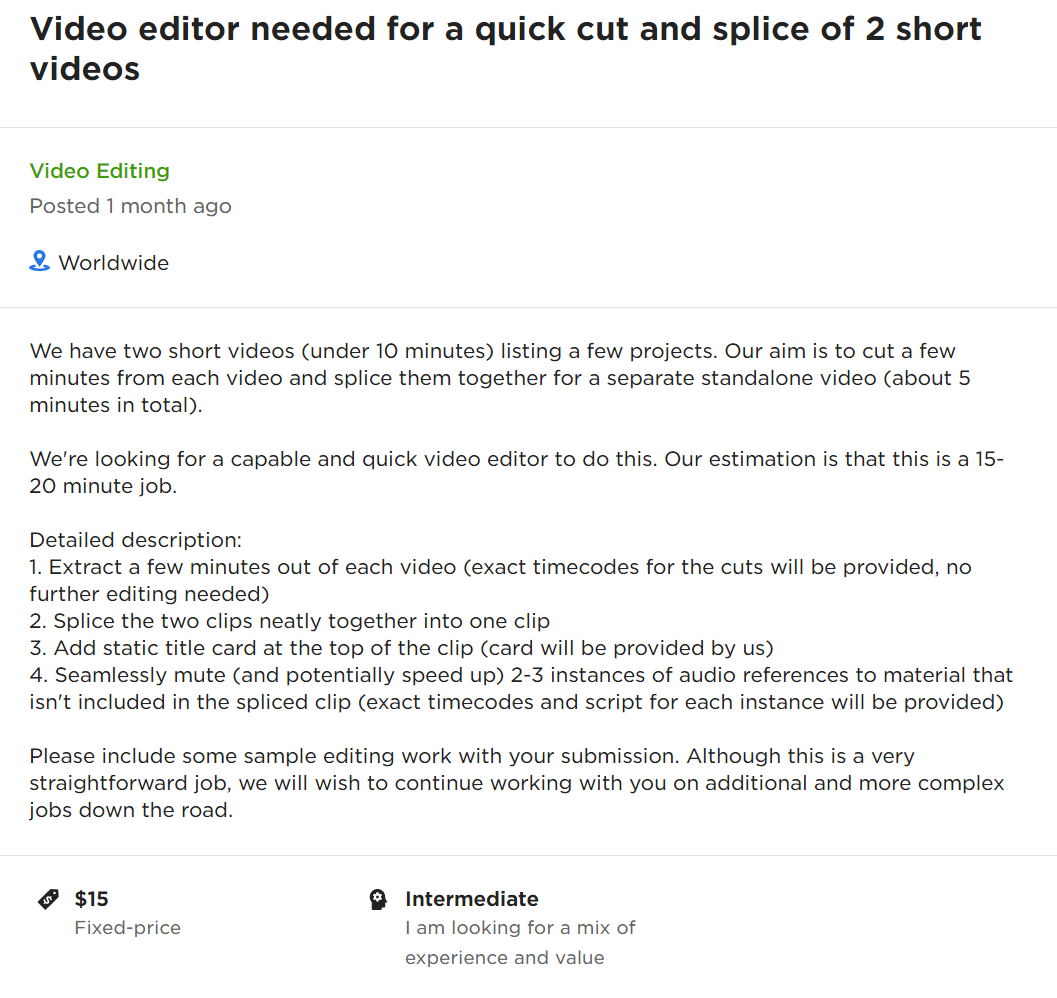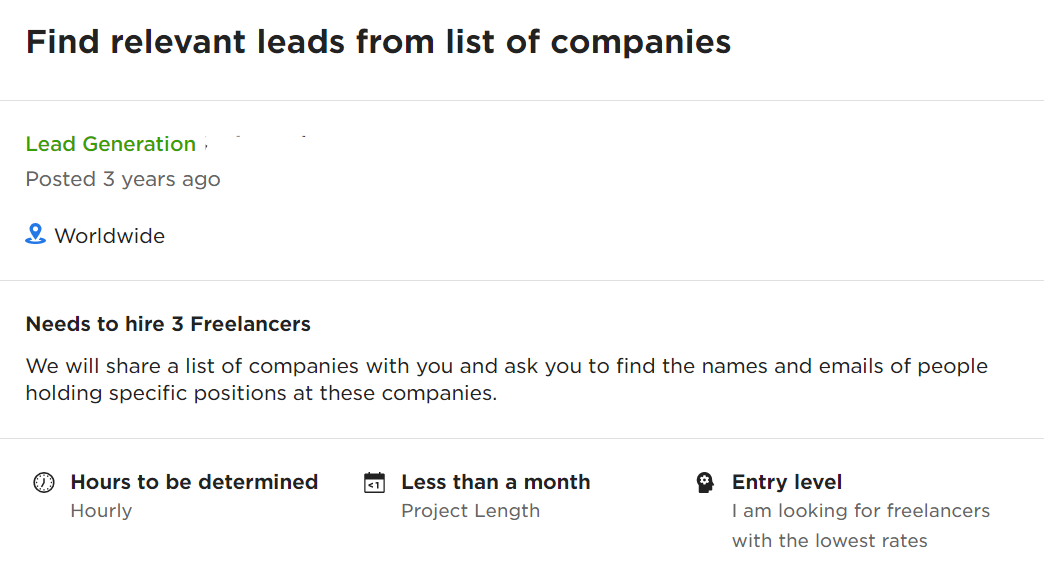You know the old saying: good help is hard to find. As a marketer, you probably keep a cherished list of favorite vendors who have helped you immensely: graphic designers, video editors, SEO experts, data providers, etc. You keep working with them as much as possible and trust them implicitly to deliver the best results every time.
But what happens when a preferred vendor isn’t available, when your budget is limited, or when something simply has to happen today?
For the past several years, our not-so-secret weapon has been finding help on freelance marketplace platforms, particularly Upwork. We’ve used freelancers on tasks including large-scale list-building, graphic design, video edits, transcription, translation, and many more one-time and recurring tasks.
Regardless of each specific project, our goals remained the same – get things done well, quickly, and affordably, and limit the amount of effort required on our end. However, there’s a learning curve involved in sifting through millions of candidates, finding the right person, and ensuring that things run smoothly and successfully. Below are a few key tactics we keep using to get (almost) everything done on Upwork.
Key tactics to getting everything done on Upwork
Posting Jobs and Hiring
- Create excellent job postings. Provide enough information to attract the best talent for your job. Include a lot of detail: budget, expected deliverables, deadlines, and a brief description of the required work. Be explicit when listing deliverables – be sure to include raw “work files” (e.g PSDs) to allow future edits. Factor in multiple review rounds. Spend some time researching similar job postings and candidates’ posted rates, and set your budget accordingly.
The following example shows a job post that was very successful in attracting applicants – over 20 in two hours:

This second example shows an unsuccessful job post – not enough details are provided for prospective applicants. We use posts like these only when hiring people we know and after discussing details in advance:

- Higher rates do not equal better work. Lower rates do not necessarily mean less experience or lower quality work. They typically correspond to where the candidate resides. So, unless it is essential to hire someone with a particular background (e.g someone who speaks Hebrew), go with someone qualified but more affordable.
- Ensure that communication won’t be an issue. During the interview process, take note of response time and clarity: if your candidate is located half a world away, make sure there’s enough overlap in your hours of availability; if English isn’t their native language, see how well you’re understood and make sure they’re able to express themselves.
- Review sample work and start with a sample project. Always ask for previous work samples. How well the samples the candidate chooses to share match with what you need, and the general quality of these samples will help with choosing the right person. When bringing in someone for a substantial enough job (e.g “find 1000 leads”), hire them to perform just the first few steps (e.g “find 10 leads”). If all seems well, great. If not, you’re only down a few $$ and can move on.
- Build a virtual team. Keep a list of workers you were pleased with, and approach them first for relevant new jobs. This will eliminate the need for all other steps detailed above and will save you a ton of time and effort. If possible, leave these workers on open contracts and eliminate the need to rehire them each time.
- Need more than one person on a job? Ask a worker you already trust for recommendations. Have them bring in people they know and have that worker train and manage his recommended colleagues. We have been successfully using this tactic repeatedly on list building and other time-consuming data research tasks, at times ramping up to teams of 10 or more people almost effortlessly.
Communication and Workflow
- Spec out your project in detail. Prepare a doc with detailed step-by-step instructions for each project: share with your Upworkers and make sure they understand everything before starting to work. Having a step-by-step guide also helps when defining milestones (e.g “Milestone 1 – complete step 3”), and when communicating or checking in on progress.
- Use shared resources. Set aside a Google Drive folder, drop resource files into it, and prep docs your workers can edit. For example, on list-building jobs, we provide a shared worksheet with a template including all of the data we require, as well as a couple of examples. Using shared resources ensures you always have visibility into the progress, and can right the ship if it’s getting off course. This also allows grabbing partial results when needed.
- However, never share originals. A basic information security guideline. Make sure you clear the copies you share of any sensitive information. Remember to revoke access once you complete the project (or use Google’s “temporary access” option and set an expiration date.)
- Be ready to communicate asynchronously. Most of your communication will be done via Upwork’s built-in chat rooms, though in some cases you may wish to get on a Zoom to speed things along. Encourage asking questions along the way, but instruct your worker to avoid delays while waiting for answers, whenever possible.
- Ensure milestones are met. Don’t “send and forget”. There’s no shared Asana workspace, so reach out to workers ahead of upcoming milestones and remind them that these are due. For complex tasks, keep the content of each milestone limited and the time between them short. After building a rapport with a certain worker, aim to include more on each milestone. You can even let them complete the job without “officially” submitting interim work (but still check in on their progress.)
- Review often, be patient and ready to iterate. Identify and address problems mid-stream to ensure final results will hit the mark. On data/textual tasks, point out issues and elaborate. Have the worker record these explanations, effectively building a knowledge base for the rest of the project. On creative tasks, whenever possible, ask to receive several options during the initial design stages, and focus on the pros and cons of each when reviewing.
- Don’t forget to collect every agreed-upon deliverable and raw file. If changes happen during the job (e.g not all file resolutions are needed), explicitly agree to them to avoid disputes. Note that agreed-upon fees can’t be adjusted downward even if less effort is actually required.
One More Thing
Be nice, be kind. A good tip in general, but especially important when hiring someone on a platform that heavily commoditizes work. Despite them not being employees, remain mindful of your Upworkers’ needs and challenges. In particular, accept that there are certain dates where work may slow down or stop (holidays, graduations, exams, weddings). Ask to be kept informed, and factor in these delays (or use your “reserves”, other workers, as necessary).
Additionally, consider incentivizing long-term workers. Bump up base fees or send over a small annual bonus for people you work with regularly. Especially for workers in third-world countries, a little something extra can go a long way. This does a lot to ensure your team remains satisfied, ensuring you won’t have to constantly search for new talent.
The Bottom Line
We’ve had great success working with freelancers on Upwork over the years. By using these tactics – build a team, communicate well and often, set and review milestones, and be kind – you should be able to do the same.








